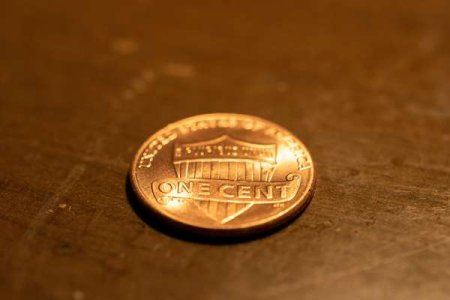
After more than two centuries of jingling in pockets, slipping between couch cushions, and being pressed into lucky souvenirs at roadside attractions, the humble US penny has officially reached the end of its long journey.
In a historic shift, the final batch of one-cent coins has rolled off the mint’s production line—marking the closing of a chapter that began in 1793.
For generations, the penny was more than just currency; it was a symbol of thrift, nostalgia, and everyday transactions. But as cash use declines and production costs rise, America is saying goodbye to its smallest coin.
So what does this mean for your wallet, your purchases, and that old change jar on your shelf?
The numbers that killed the penny
The penny’s retirement wasn’t driven by nostalgia—it was a numbers game.
In 2024, the US mint spent nearly 3.69 cents to make and circulate a single one-cent coin, meaning every penny cost more than triple its face value. Multiply that by the 3.2 billion pennies minted that year, and the numbers become staggering.
While their total face value was just $31.7 million, production costs soared past $85 million. The result? A costly imbalance that made one thing clear: continuing to produce the penny was no longer financially viable.
Since 2006, the US mint has consistently spent more to make each penny than the coin is actually worth. That’s nearly 20 years of manufacturing a one-cent piece at a loss—year after year, the cost outweighed the value. It’s a long-running imbalance that turned small change into a big financial drain.
While the penny’s exit won’t break the bank for most Americans, it does come with a small cost.
A study from the Federal Reserve Bank of Richmond estimates that rounding purchases to the nearest five cents could add up to around $6 million annually for consumers. Spread across 133 million households, that’s roughly five cents per family—a tiny dent, but a real one nonetheless.

Copper keeps its value (for now)
If you’ve got jars of pennies tucked away in drawers or stashed in coin banks, don’t worry—they’re still good to use.
Even though the US mint has stopped producing new one-cent coins, existing pennies remain legal tender. That means you can still spend them, deposit them, or use them for exact change.
Over time, though, these copper coins will become less common in everyday transactions, quietly fading from circulation as the country adjusts to life without them.
Retail chaos as the pennies run dry
The penny’s farewell hasn’t exactly gone smoothly.
Across several regions, retailers are already running low on one-cent coins, leaving them unable to give exact change.
Banks, too, are feeling the squeeze—they can’t order new pennies and have started rationing what little supply remains for their customers. What was expected to be a gradual transition is turning into a scramble for the last few coins in circulation.
In response, retailers are getting inventive as the penny shortage hits home.
One chain, Sheetz, turned the coin crunch into a quirky promotion—offering a free soda to anyone who brought in 100 pennies. Meanwhile, Kwik Trip, a popular Midwest convenience store, chose a more generous route: rounding down every cash purchase to the nearest five cents. That small gesture is expected to cost the company around $3 million this year, showing just how far some businesses are willing to go to ease the transition.
Also read: Do you have these rare pennies? Find out if your spare change could be worth hundreds!

A coin steeped in history and sentiment
The penny’s story stretches back long before Abraham Lincoln’s profile became its signature look.
In fact, the one-cent coin was among the earliest pieces of American currency, first struck in 1787—well before the US mint officially came into existence.
That original coin, known as the Fugio cent, is often attributed to Benjamin Franklin, who reportedly infused it with his signature wit and practicality. It marked the beginning of a coinage legacy that would last over two centuries.
The penny as we know it today, bearing Abraham Lincoln’s profile, made its debut in 1909 to honor the 100th anniversary of his birth. It marked a turning point in US coin design, becoming the first to showcase a real historical figure rather than the traditional allegorical images of Liberty that had graced earlier coins. This shift signaled a new era in American currency, one that celebrated national leaders alongside enduring ideals.
The design of the penny has gone through quite a transformation since its early days. The first official version appeared in 1793, showcasing a youthful Lady Liberty with long, windswept hair—a look that some observers at the time found more startled than serene.
These original coins were made entirely of copper and were noticeably larger than today’s penny, roughly matching the size of a modern quarter. It was a bold beginning for a coin that would become a fixture in American life for over two centuries.
What collectors need to know
For coin enthusiasts and collectors, the end of penny production marks a historic turning point.
Although older pennies will still be accepted as currency, the halt in minting new ones adds a layer of rarity to recent issues. Pennies stamped with 2024 dates and specific mint marks may become especially sought-after, as they represent the final chapter in a coinage tradition that spanned more than two centuries.
The final batch of circulating pennies was minted back in June, marking the quiet end of an era. Although a ceremonial event was held more recently, it served only as a symbolic farewell.
Going forward, the US mint will no longer produce pennies for everyday use. Instead, any new one-cent coins will be limited-edition collectibles—not legal tender—released in small quantities for numismatists and history buffs alike.
Memories and musings
Retiring the penny isn’t just a financial decision—it’s a cultural milestone.
For over two centuries, this small coin carried more than monetary value; it reflected national identity, historical memory, and symbolic meaning.
As Frank Holt, emeritus professor at the University of Houston and coin historian, put it: “We put mottos on them and self-identifiers, and we decide—in the case of the United States —which dead persons are most important to us and should be commemorated.” With the penny’s departure, Americans are not only saying goodbye to a familiar piece of change, but also to a tradition of storytelling through currency.
As we adjust to life without newly minted pennies, it helps to remember that change doesn’t have to be disruptive. Sometimes, the simplest solution—letting go of what no longer serves its purpose—is also the most practical.
The shift may feel unfamiliar at first, but everyday transactions will adapt, and the absence of the penny will soon feel like second nature.
How do you feel about retiring small-denomination coins? Will the end of the penny change how you handle everyday purchases—or has digital payment already made cash feel like a thing of the past?
And if you’ve got a jar of old pennies tucked away, now might be the time to take a closer look. With production officially ended, some dates and mint marks could catch the eye of collectors. What used to be everyday pocket change might just turn out to be a tiny piece of American history.






